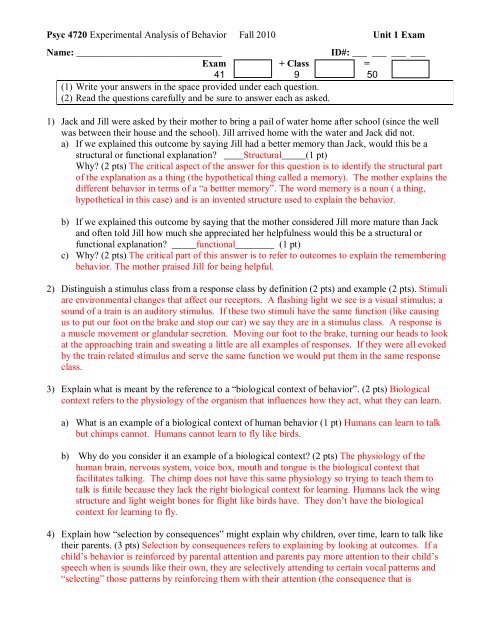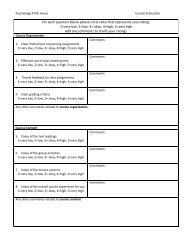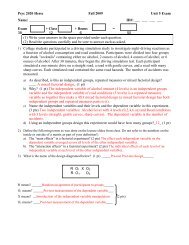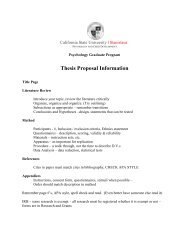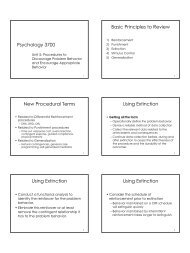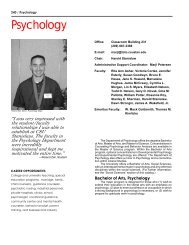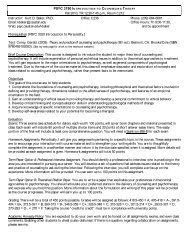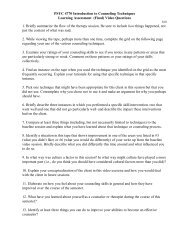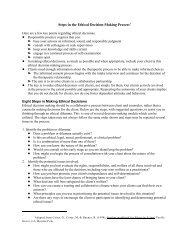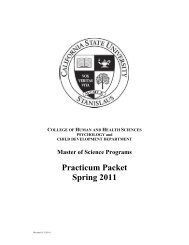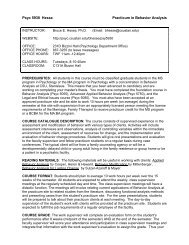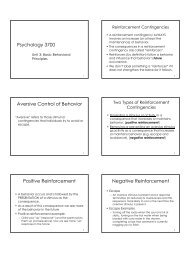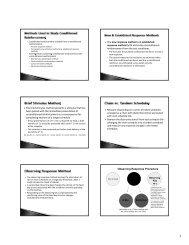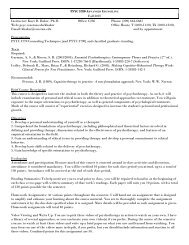(1) Leave a one inch margin on the left side of your answer sheet
(1) Leave a one inch margin on the left side of your answer sheet
(1) Leave a one inch margin on the left side of your answer sheet
Create successful ePaper yourself
Turn your PDF publications into a flip-book with our unique Google optimized e-Paper software.
Psyc 4720 Experimental Analysis <strong>of</strong> Behavior Fall 2010 Unit 1 Exam<br />
Name: ______________________________<br />
ID#: ___ ___ ___ ___<br />
Exam + Class =<br />
41 9 50<br />
(1) Write <strong>your</strong> <strong>answer</strong>s in <strong>the</strong> space provided under each questi<strong>on</strong>.<br />
(2) Read <strong>the</strong> questi<strong>on</strong>s carefully and be sure to <strong>answer</strong> each as asked.<br />
1) Jack and Jill were asked by <strong>the</strong>ir mo<strong>the</strong>r to bring a pail <strong>of</strong> water home after school (since <strong>the</strong> well<br />
was between <strong>the</strong>ir house and <strong>the</strong> school). Jill arrived home with <strong>the</strong> water and Jack did not.<br />
a) If we explained this outcome by saying Jill had a better memory than Jack, would this be a<br />
structural or functi<strong>on</strong>al explanati<strong>on</strong>? ____Structural_____(1 pt)<br />
Why? (2 pts) The critical aspect <strong>of</strong> <strong>the</strong> <strong>answer</strong> for this questi<strong>on</strong> is to identify <strong>the</strong> structural part<br />
<strong>of</strong> <strong>the</strong> explanati<strong>on</strong> as a thing (<strong>the</strong> hypo<strong>the</strong>tical thing called a memory). The mo<strong>the</strong>r explains <strong>the</strong><br />
different behavior in terms <strong>of</strong> a “a bettter memory”. The word memory is a noun ( a thing,<br />
hypo<strong>the</strong>tical in this case) and is an invented structure used to explain <strong>the</strong> behavior.<br />
b) If we explained this outcome by saying that <strong>the</strong> mo<strong>the</strong>r c<strong>on</strong><strong>side</strong>red Jill more mature than Jack<br />
and <strong>of</strong>ten told Jill how much she appreciated her helpfulness would this be a structural or<br />
functi<strong>on</strong>al explanati<strong>on</strong>? _____functi<strong>on</strong>al________ (1 pt)<br />
c) Why? (2 pts) The critical part <strong>of</strong> this <strong>answer</strong> is to refer to outcomes to explain <strong>the</strong> remembering<br />
behavior. The mo<strong>the</strong>r praised Jill for being helpful.<br />
2) Distinguish a stimulus class from a resp<strong>on</strong>se class by definiti<strong>on</strong> (2 pts) and example (2 pts). Stimuli<br />
are envir<strong>on</strong>mental changes that affect our receptors. A flashing light we see is a visual stimulus; a<br />
sound <strong>of</strong> a train is an auditory stimulus. If <strong>the</strong>se two stimuli have <strong>the</strong> same functi<strong>on</strong> (like causing<br />
us to put our foot <strong>on</strong> <strong>the</strong> brake and stop our car) we say <strong>the</strong>y are in a stimulus class. A resp<strong>on</strong>se is<br />
a muscle movement or glandular secreti<strong>on</strong>. Moving our foot to <strong>the</strong> brake, turning our heads to look<br />
at <strong>the</strong> approaching train and sweating a little are all examples <strong>of</strong> resp<strong>on</strong>ses. If <strong>the</strong>y were all evoked<br />
by <strong>the</strong> train related stimulus and serve <strong>the</strong> same functi<strong>on</strong> we would put <strong>the</strong>m in <strong>the</strong> same resp<strong>on</strong>se<br />
class.<br />
3) Explain what is meant by <strong>the</strong> reference to a “biological c<strong>on</strong>text <strong>of</strong> behavior”. (2 pts) Biological<br />
c<strong>on</strong>text refers to <strong>the</strong> physiology <strong>of</strong> <strong>the</strong> organism that influences how <strong>the</strong>y act, what <strong>the</strong>y can learn.<br />
a) What is an example <strong>of</strong> a biological c<strong>on</strong>text <strong>of</strong> human behavior (1 pt) Humans can learn to talk<br />
but chimps cannot. Humans cannot learn to fly like birds.<br />
b) Why do you c<strong>on</strong><strong>side</strong>r it an example <strong>of</strong> a biological c<strong>on</strong>text? (2 pts) The physiology <strong>of</strong> <strong>the</strong><br />
human brain, nervous system, voice box, mouth and t<strong>on</strong>gue is <strong>the</strong> biological c<strong>on</strong>text that<br />
facilitates talking. The chimp does not have this same physiology so trying to teach <strong>the</strong>m to<br />
talk is futile because <strong>the</strong>y lack <strong>the</strong> right biological c<strong>on</strong>text for learning. Humans lack <strong>the</strong> wing<br />
structure and light weight b<str<strong>on</strong>g><strong>on</strong>e</str<strong>on</strong>g>s for flight like birds have. They d<strong>on</strong>’t have <strong>the</strong> biological<br />
c<strong>on</strong>text for learning to fly.<br />
4) Explain how “selecti<strong>on</strong> by c<strong>on</strong>sequences” might explain why children, over time, learn to talk like<br />
<strong>the</strong>ir parents. (3 pts) Selecti<strong>on</strong> by c<strong>on</strong>sequences refers to explaining by looking at outcomes. If a<br />
child’s behavior is reinforced by parental attenti<strong>on</strong> and parents pay more attenti<strong>on</strong> to <strong>the</strong>ir child’s<br />
speech when is sounds like <strong>the</strong>ir own, <strong>the</strong>y are selectively attending to certain vocal patterns and<br />
“selecting” those patterns by reinforcing <strong>the</strong>m with <strong>the</strong>ir attenti<strong>on</strong> (<strong>the</strong> c<strong>on</strong>sequence that is
Psyc 4720 Experimental Analysis <strong>of</strong> Behavior Fall 2010 Unit 1 Exam<br />
selecting which vocal pattern will be repeated in <strong>the</strong> future.<br />
a) Would you c<strong>on</strong><strong>side</strong>r this selecti<strong>on</strong> at <strong>the</strong> phylogenic level or <strong>the</strong> <strong>on</strong>togenic level? (1 pt)<br />
Ontogenic<br />
b) Why? (2 pts) It is learning (a behavior change) that is occurring within <strong>the</strong> lifetime <strong>of</strong> <strong>the</strong> child<br />
and not a change in behavioral tendencies across generati<strong>on</strong>s <strong>of</strong> <strong>the</strong> species.<br />
5) Is <strong>the</strong> model <strong>of</strong> causati<strong>on</strong> described in questi<strong>on</strong> 4 an example <strong>of</strong> immediate causati<strong>on</strong> or remote<br />
causati<strong>on</strong>? (1 pt). ____remote_______<br />
a) Explain why you c<strong>on</strong><strong>side</strong>r it an example <strong>of</strong> this type <strong>of</strong> causati<strong>on</strong>. (2 pts) The behavior change<br />
is not elicited by a prior stimulus in an immediate sense but is gradually brought about by a<br />
history <strong>of</strong> c<strong>on</strong>sequences (a history or reinforcement). Past c<strong>on</strong>sequences make <strong>the</strong> speech<br />
patterns <strong>of</strong> <strong>the</strong> child that sound like <strong>the</strong> parent more likely and <str<strong>on</strong>g><strong>on</strong>e</str<strong>on</strong>g>s that d<strong>on</strong>’t sound like <strong>the</strong><br />
parent less likely. There is a l<strong>on</strong>ger time period between <strong>the</strong> causal event and <strong>the</strong> outcome.<br />
6) What are “establishing operati<strong>on</strong>s” (<strong>of</strong>ten referred to as motivating operati<strong>on</strong>s now)? (2 pts)<br />
Establishing operati<strong>on</strong>s make c<strong>on</strong>sequences more or less reinforcing and evoke (or inhibit) <strong>the</strong><br />
behavior that has produced <strong>the</strong>se c<strong>on</strong>sequences in <strong>the</strong> past.<br />
a) How would you use this to explain why a dog will do tricks for praise and pats at home but will<br />
not do <strong>the</strong> tricks at <strong>the</strong> park where <strong>the</strong>y just run around sniffing everything? (2 pts) At home<br />
praise and pats are reinforcing because home envir<strong>on</strong>ment is familiar and <strong>the</strong> praise and pats<br />
have been established as reinforcers. At <strong>the</strong> park <strong>the</strong> EO has changed because <strong>the</strong>re are o<strong>the</strong>r<br />
reinforcers (novel smells) available. Sniffing is <strong>the</strong> behavior evoked because <strong>of</strong> <strong>the</strong> present<br />
str<strong>on</strong>g reinforcer <strong>of</strong> novel smells and praise or pats are less reinforcing in this envir<strong>on</strong>ment. If<br />
we could make access to <strong>the</strong> smells c<strong>on</strong>tingent <strong>on</strong> doing tricks, <strong>the</strong> dog would do that for <strong>the</strong><br />
smells ra<strong>the</strong>r than <strong>the</strong> pats at <strong>the</strong> park but do it for <strong>the</strong> pats at home where no new smells are<br />
present.<br />
7) Describe an example <strong>of</strong> a single-subject research design. Say what changes in <strong>the</strong> data (trend and<br />
level in <strong>the</strong> various c<strong>on</strong>diti<strong>on</strong>s) are needed to determine <strong>the</strong> independent variable produced <strong>the</strong><br />
effects in <strong>the</strong> dependent variable. (6 pts) ABAB or Multiple Baseline research design. Include a<br />
baseline where DV is measured for several sessi<strong>on</strong>s without interventi<strong>on</strong> <strong>of</strong> IV. Introduce IV while<br />
holding everything else c<strong>on</strong>stant and c<strong>on</strong>tinue measuring DV for several sessi<strong>on</strong>s. In Multiple<br />
baseline do this in a staggered sequence with three settings, three behaviors or three participants. In<br />
ABAB, repeat <strong>the</strong> baseline and interventi<strong>on</strong> phases. If <strong>the</strong> data in <strong>the</strong> baselines are stable (no<br />
trends up or down) at a particular level and <strong>the</strong>n changes quickly to a new level (<strong>of</strong>ten trending up<br />
or down) when <strong>the</strong> IV is present we say we have an effect. If we return to baseline c<strong>on</strong>diti<strong>on</strong>s and<br />
<strong>the</strong> data return to baseline levels (trending back to <strong>the</strong> previous level) we have evidence that our<br />
interventi<strong>on</strong> caused our DV change. In <strong>the</strong> Multiple Baseline design we should see changes in<br />
level and trend in each <strong>of</strong> <strong>the</strong> graphs ONLY when <strong>the</strong> interventi<strong>on</strong> was introduced.
Psyc 4720 Experimental Analysis <strong>of</strong> Behavior Fall 2010 Unit 1 Exam<br />
8) How does <strong>the</strong> experimental analysis <strong>of</strong> behavior differ from what is usually found in applied<br />
behavior analysis? (2 pts) EAB involves basic research in which <strong>the</strong> studies are c<strong>on</strong>ducted to<br />
discover new knowledge or principles. ABA seeks to discover soluti<strong>on</strong>s to practical problems<br />
usually in applied settings.<br />
9) What do behavior analysts mean by culture (2 pts)? C<strong>on</strong>sistent c<strong>on</strong>diti<strong>on</strong>s arranged by a group to<br />
regulate <strong>the</strong> behavior <strong>of</strong> individuals. These c<strong>on</strong>diti<strong>on</strong>s are c<strong>on</strong><strong>side</strong>red cultural practices.<br />
a) What is “cultural evoluti<strong>on</strong>” (2 pts) and why would behavior analysts be interested in it? (1 pt)<br />
Cultural practices are selected by <strong>the</strong>ir c<strong>on</strong>sequences and cultures gradually change because <strong>of</strong><br />
this (called cultural evoluti<strong>on</strong>). Because behavior analysts are interested in what influences <strong>the</strong><br />
behavior <strong>of</strong> individuals <strong>the</strong>y study cultural practices and how <strong>the</strong>y change so <strong>the</strong>y can better<br />
explain <strong>the</strong> behavior patterns <strong>of</strong> those <strong>the</strong>y study<br />
---------------------------------------------B<strong>on</strong>us Points------------------------------------------------<br />
10) What c<strong>on</strong>tributi<strong>on</strong>s to behavior analysis are associated with :<br />
a) J.B. Wats<strong>on</strong>? (1 pt) Fa<strong>the</strong>r <strong>of</strong> Behaviorism. Brought Pavlov’s c<strong>on</strong>diti<strong>on</strong>ing methods to<br />
American psychologists.<br />
b) E. Thorndike? (1 pt) Law <strong>of</strong> Effect. Used cats to be <strong>the</strong> first American psychologist to study<br />
<strong>the</strong> way c<strong>on</strong>sequences affect behavior.<br />
11) How did Skinner differ from Wats<strong>on</strong> when referring to internal events such as thoughts and<br />
feelings? (2 pts) Both acknowledge internal events but Wats<strong>on</strong> ignored <strong>the</strong>m in his approach<br />
because <strong>the</strong>y couldn’t be studied objectively. Skinner included <strong>the</strong>m in his analysis but not a<br />
special causal events but as more stimuli and resp<strong>on</strong>ses to be c<strong>on</strong><strong>side</strong>red.


